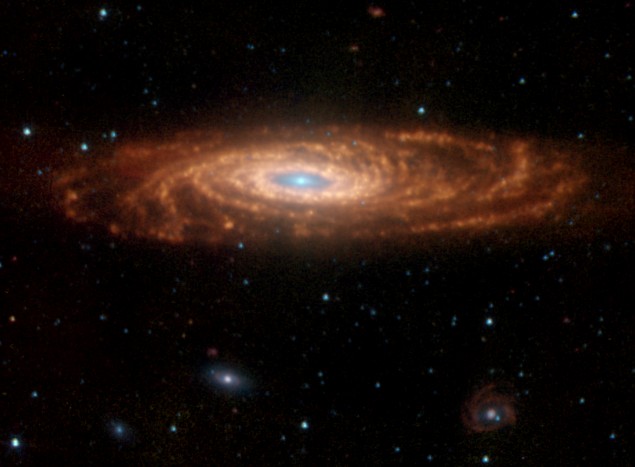Explanation: If our own Milky Way galaxy were 50 million light-years away with its disk inclined slightly to our line of sight, it would look a lot like large spiral galaxy NGC 7331. In fact, seen here in a false-color infrared image from the Spitzer Space Telescope, NGC 7331 is interesting in part because it is thought to be so similar to the Milky Way. Light from older, cooler stars, shown in blue, dominates the central bulge of NGC 7331, while Spitzer data also indicates the presence of a black hole within this galaxy's central regions - about the same size as the black hole at our own galactic core. Shown in red and brown, radiation from complex molecules associated with dust traces NGC 7331's star forming spiral arms. The arms span around 100,000 light-years, about the size of the Milky Way. Curiously, a further star forming ring is visible in yellowish hues, 20,000 light-years or so from the center of NGC 7331, but it is not known if such a structure exists within our own galaxy.
News: Cassini to Saturn mission
update
1999 2000 2001 2002 2003 2004 2005 2006 2007 2008 2009 2010 2011 2012 2013 2014 2015 2016 2017 2018 2019 2020 2021 2022 2023 2024 2025 |
Yanvar' Fevral' Mart Aprel' Mai Iyun' Iyul' Avgust Sentyabr' Oktyabr' Noyabr' Dekabr' |
NASA Web Site Statements, Warnings, and Disclaimers
NASA Official: Jay Norris. Specific rights apply.
A service of: LHEA at NASA / GSFC
& Michigan Tech. U.
|
Publikacii s klyuchevymi slovami:
infrared - galaktika, spiral'naya - infrakrasnoe izluchenie
Publikacii so slovami: infrared - galaktika, spiral'naya - infrakrasnoe izluchenie | |
Sm. takzhe:
Vse publikacii na tu zhe temu >> | |
